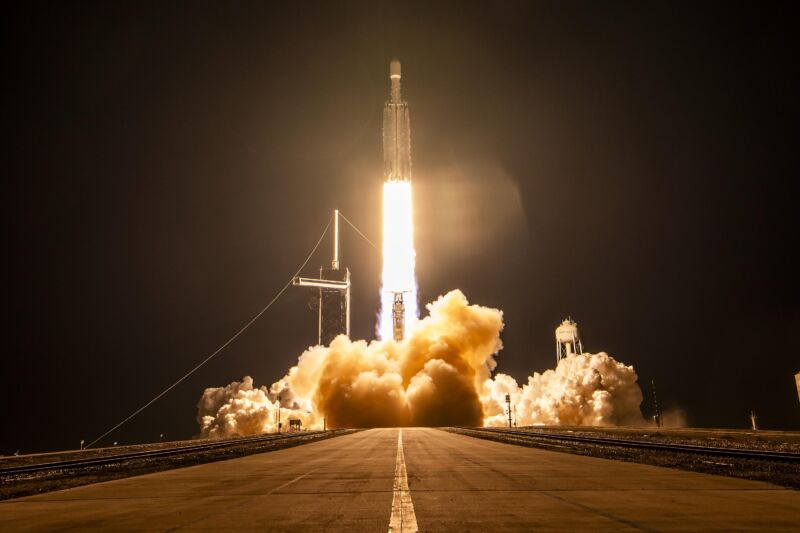
Enlarge / SpaceX’s Falcon Heavy rocket lifted off Thursday night from NASA’s Kennedy Space Center in Florida.
It seems like SpaceX did everything this year but launch 100 times.
On Thursday night, the launch company sent two more rockets into orbit from Florida. One was a Falcon Heavy, the world’s most powerful rocket in commercial service, carrying the US military’s X-37B spaceplane from a launch pad at NASA’s Kennedy Space Center at 8: 07 pm EST (01: 07 UTC). Less than three hours later, at 11: 01 pm EST (04: 01 UTC), SpaceX’s workhorse Falcon 9 launcher took off a few miles to the south with a payload of 23 Starlink Internet satellites.
The Falcon Heavy’s two side boosters and the Falcon 9’s first stage landed back on Earth for reuse.
These were SpaceX’s final launches of 2023. SpaceX ends the year with 98 flights, including 91 Falcon 9s, five Falcon Heavy rockets, and two test launches of the giant new Super Heavy-Starship rocket. These flights were spread across four launch pads in Florida, California, and Texas.
Elon Musk, SpaceX’s founder and CEO, set a goal of 100 launches this year, up from the company’s previous record of 61 in 2022. For a while, it looked like SpaceX was on track to accomplish the feat, but a spate of bad weather and technical problems with the final Falcon Heavy launch of the year kept the company short of 100 flights.
King of ‘upmass’
“Congrats to the entire Falcon team at SpaceX on a record breaking 96 launches in 2023!” wrote Jon Edwards, vice president of Falcon launch vehicles at SpaceX, on the social media platform X. “I remember when Elon Musk first threw out a goal of 100 launches as a thought experiment, intended to unlock our thinking as to how we might accelerate Falcon across all levels of production and launch.
“Only a few years later and here we are,” Edwards wrote. “I’m so incredibly proud to work with the best team on Earth, and so excited to see what we achieve next year.”
It’s important to step back and put these numbers in context. No other family of orbit-class rockets has ever flown more than 63 times in a year. SpaceX’s Falcon rockets have now exceeded this number by roughly 50 percent. SpaceX’s competitors in the United States, such as United Launch Alliance and Rocket Lab, managed far fewer flights in 2023. ULA had three missions, and Rocket Lab launched its small Electron booster 10 times.
Nearly two-thirds of SpaceX’s missions this year were dedicated to delivering satellites to orbit for SpaceX’s Starlink broadband network, a constellation that now numbers more than 5,000 spacecraft.
SpaceX also launched five missions with the Falcon Heavy rocket, created by aggregating three Falcon 9 rocket boosters together. Highlights from SpaceX’s 2023 Falcon launch schedule included three crew missions to the International Space Station, and the launch of NASA’s Psyche mission to explore a metallic asteroid.
In all, SpaceX’s Falcon rockets hauled approximately 1,200 metric tons, or more than 2.6 million pounds, of payload mass into orbit this year. This “upmass” is equivalent to nearly three International Space Stations. Most of this was made up of mass-produced Starlink satellites.